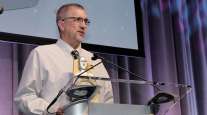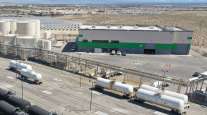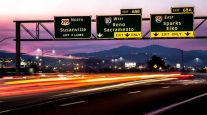Senior Reporter
Southern Nevada’s Freight Corridor Gets the Vegas Treatment
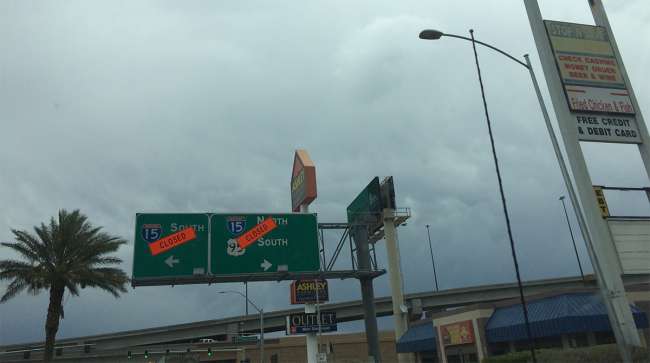
LAS VEGAS — Before dawn on weekdays Paul DeLong arrives downtown to lead his team of commercial drivers in transporting equipment back and forth at construction sites for a project aimed at improving the work lives of truckers like him.
His crew averages eight trips per shift using as many as six Western Star trucks during these final months of the aptly named Project Neon.
The $1 billion project will widen Interstate 15 at the U.S. 95 interchange “Spaghetti Bowl,” commonly known for its bumper-to-bumper traffic — and accidents.
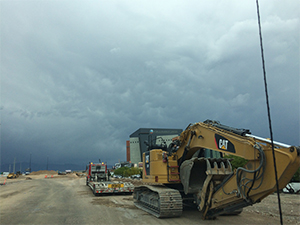
Construction is ongoing near the Spaghetti Bowl. (Eugene Mulero/Transport Topics)
On a rare rainy afternoon on May 1, when Transport Topics caught up with DeLong and the construction crew with Kiewit Infrastructure West Co., a driver had taken an excavator with a magnet attachment from a yard at Bonanza Road and transported it to the Charleston Boulevard site, just a few miles from the heart of a city inundated with tourists, celebrities, street performers and the many locals who live here. All the while, the crew from Kiewit removed the remnants of a bridge that had been turned to rubble to make room for the road expansion.
For DeLong, owner of a local eponymous heavy-haul firm operating since the mid-’80s and a member of the Nevada Trucking Association, Project Neon is not the typical highway renovation.
The project will mark a better way to access the periphery of America’s playground. The much-needed boost for truckers will increase lane capacity at the state’s southern premier freight corridor. Passing through it will be quicker, and safer.
As DeLong put it, Project Neon will hopefully “eliminate the congestion getting through the Las Vegas area, north and south.”
Project managers anticipate a reduction in congestion by 30% after completion, as well as a reduction in the average of three accidents daily. The reduction in truck traffic and travel delays will likely result in $110 million annual savings for the freight industry and motorists through increased productivity, the Nevada Department of Transportation estimates.
Project Neon, the largest public works project in state history, targets 3.7 miles on the interstate between Sahara Avenue and the interchange with the Spaghetti Bowl. Sahara Avenue is about 2.5 miles north of the Strip, and the Spaghetti Bowl is the busiest stretch of highway in Nevada with some 25,000 lane changes hourly.
Project Goals
At the site about half a dozen construction workers with Kiewit donning hard hats were stationed at the Bonanza Road yard. A crew member used an excavator with a magnet attachment to asses debris from the demolished old roadway in order to access metal while another crew member collected rubble with a bulldozer for disposal, construction that will continue for nearly a year as ramps and miles of roadway have yet to be paved.
The project will include high-occupancy vehicle lanes, and an intricate active traffic management system consisting of 42 massive electronic message boards. Nine boards have been installed with six already operational, said Susan Berkley, the project’s public involvement coordinator. The boards are designed to promote speed harmonization by alerting drivers of accidents and severe traffic or weather.
Fuel consumption would improve for freight haulers by reducing the amount of “stop-and-go” movement on the roadway. This could lead to fuel savings as high as 40%, city officials with the mayor’s office estimate.
The project is funded primarily through state revenue bonds. The city contributed $75 million in locally obligated federal highway funds, according to project managers. Construction kicked off nearly two years ago with completion projected for summer 2019. And when it is finished — each road meticulously in its place — Project Neon will be its own salute to the local ethos: What happens in Vegas, stays in Vegas.
Truckers are anticipating the change considering traffic through the corridor is expected to double by 2035. Several drivers familiar with I-15 said that it’s a huge delay. However, notwithstanding the congested bottlenecks, truckers “gotta be safe out there,” said Gragg Wilson of FedEx Freight.
Better Access
The Las Vegas metropolitan area is a shipping and freight hub demanding constant supplies of food, goods and services to maintain various industries.
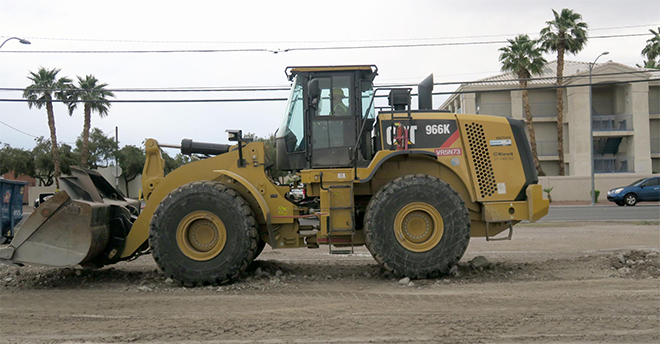
A bulldozer at the Bonanza Road yard. (Eugene Mulero/Transport Topics)
Of the 300,000 vehicles on the Spaghetti Bowl every day, about 17,900 on I-15 are trucks. U.S. 95 along the same stretch is used by 2,000 trucks daily, according to NDOT. Commercial drivers travel to and from California’s ports and southwest hubs to reach warehouses, storage facilities and construction sites. Other truckers focus primarily on last-mile routes across the metropolitan area, and longhaul truckers rely on the corridor en route to states farther north or east.
With $95 billion of commerce traveling annually along the corridor, congestion leads to potential slowdowns in local and state economies. That concern prompted emphasis on freight for the project, explained Dale Keller, Project Neon’s senior project manager.
“We’re not in the business anymore of moving vehicles. We’re about moving people and goods. So, that method and that model really applies to this [Project Neon] by creating different transportation choices that we have,” Keller said. “You’ve seen out here our footprint: You can’t get any wider, right? It’s very expensive. So we’re trying to find these other choices, other transportation solutions to implement that.”
Infrastructure Week
Our reporters kicked off the week with a look at how some new ideas are playing out in Nevada.“Anything we can do to improve that efficiency and moving people and goods really has a bottom-line impact,” added Tony Illia, a spokesman with the department.
The high volume of tourists visiting “Sin City” every week, coupled with the state’s growing population, were catalysts for the project, explained Paul Moradkhan, vice president of government affairs at the Las Vegas Metro Chamber of Commerce. According to data presented by the University of Nevada, Las Vegas, the state experienced a 31.8% population growth rate from 2000 to 2010. That was followed by a population growth of 8.5% from 2011 to 2016.
“There’s several key factors that always come up in this conversation. It’s congestion. It’s travel of goods. It’s safety, the creation of jobs, travel delays,” Moradkhan said. “All those will be addressed with the construction, and reconfiguration of Project Neon.”
Mayor Carolyn Goodman, a staunch supporter of Project Neon, boasts about her city’s place as an exemplar for intermodal freight transportation. Las Vegas is part of a trend, with Newark, N.J., and Denver, among cities that have enhanced commercial transportation.
A Model

Goodman
Goodman noted those steady transportation enhancements have earned the city praise from peers at the U.S. Conference of Mayors. Also, national leaders, such as former Transportation Secretary Anthony Foxx, had told officials to study Las Vegas’ modernization efforts. Foxx, formerly mayor of Charlotte, N.C., as secretary had championed the need for enhancing capacity along I-15 beyond the metropolitan area.
For Project Neon, the mayor’s hope is similar to DeLong’s. Basically, the goal of the project is to “open up the clog of two lanes in each direction” at the Spaghetti Bowl, she said during an interview on April 30 at her downtown office.
After Project Neon, attention will need to turn to other infrastructure needs, she cautioned. The American Society of Civil Engineers graded the state’s infrastructure a C-minus in 2014, calling for additional work to enhance mobility in urban and rural areas.
“Every city in this country pretty much has the same issues every other city has. But, sadly, all of us have to go to the top of the mountain and look singularly at a prioritized list of what’s the most important. The first one is safety,” the mayor said, “and right under that is the horrible condition of the infrastructure in this country. And you gotta fix it.”


